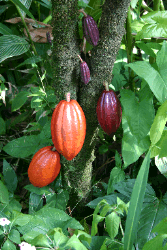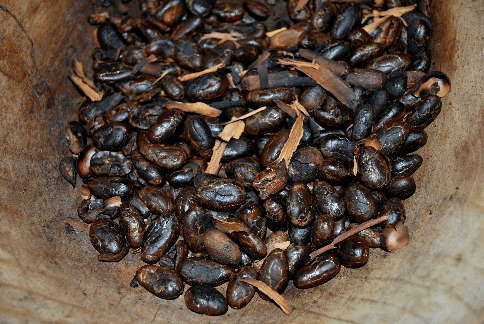|
CHOCOLATE TOXICITY

Chocolate may be America’s favorite flavor. We like chocolate candy, chocolate ice cream, chocolate drinks, chocolate cakes, just about anything with chocolate. We may want to share our favorite treat with an eager pet but it is best to think twice and reach for the dog biscuits instead.
(Photocredit: all images Morguefile.com)
DIFFERENT TYPES OF CHOCOLATE AND HOW THEY ARE MADE
|
Everyone who has ever eaten candy knows there are many types of chocolate: milk, dark, white, unsweetened, cocoa powder etc. It turns out each type has a different potential for toxicity. In order to understand which types of chocolates are more toxic, we will need to review how chocolate is made.
Cocao trees, which require a tropical climate, are farmed in orchards as any other fruit-bearing tree. The fruit of the cacao tree, called a cacao pod, is sweet and attracts monkeys or other wildlife who eat the fruit but not the bitter seeds. The seeds are discarded in the natural setting, allowing new trees to grow. Outside of the farm situation, the seeds cannot be released from the fruit unless some type of animal breaks the fruit open. Ironically, it is the bitter seeds, packed with theobromine and caffeine, which are used to make chocolate.
The pods grow directly off the trunk of the cacao tree and must be harvested by hand so as not to damage the tree. The pods are split, and the seeds are scooped out and left to ferment under banana leaves for about a week. This process turns the cocoa seeds the rich brown color with which we are familiar and creates the chocolate flavor we crave. The seeds are then dried out for another week, packed in sacks, and shipped to chocolate manufacturers. The seeds must be roasted, ground, pressed to remove the seed oil (this oil is called "cocoa butter" and is used in sunscreens, white chocolate, and cosmetics among other things), and finally tempered to create the exact consistency.
|

Cacao pods growing on the tree.
(Photocredit: Public Domain image
via Wikimedia Commons)
|

Roasted Cacao beans
(Photocredit: AlejandroLinaresGarcia via Wikimedia Commons)
- Chocolate liquor is the liquid that results from grinding the hulled cacao beans.
- Cocoa butter is the fat that is extracted from the chocolate liquor.
- Cocoa powder is the solid that remains after the cocoa butter is removed from the chocolate liquor. The powder can be treated with alkali in a process called “Dutching” or it can be left alone. Note the low-fat nature of cocoa powder, hence its use in low-fat baking.
- Unsweetened ("baking") chocolate is basically straight chocolate liquor containing 50% to 60% cocoa butter.
- Dark chocolate (also known as semisweet chocolate) is chocolate that is 35% chocolate liquor (the rest being sugar, vanilla, or lecithin).
- Milk chocolate is chocolate that is at least 10% chocolate liquor, the rest being milk solids, vanilla or lecithin.
It is the chocolate liquor that has all the problem biochemicals. The more chocolate liquor is in the end product (i.e. how dark the chocolate is), the more toxic it is.
WHY IS CHOCOLATE BAD?
PANCREATITIS
Sometimes we eat chocolate plain, as in candy. Sometimes we eat it baked into cakes, mixed into ice cream, etc. Sometimes we share these treats with pets and sometimes our pets share these treats without our permission. As far as pets are concerned, the first potential problem with these sweets is the fat. A sudden high fat meal (such as demolishing a bag of chocolate bars left accessible at Halloween time) can create a lethal metabolic disease in dogs called “pancreatitis.” Vomiting, diarrhea, and abdominal pain are just the beginning of this disaster. Remember, in the case of pancreatitis, it is the fat that causes the problem more than the chocolate itself.
The fat and sugar in the chocolate can create an unpleasant but temporary upset stomach. This is what happens in most chocolate ingestion cases.
THEOBROMINE AND CAFFEINE
Chocolate is, however, directly toxic because it contains methylxanthines. In particular the methylxanthines chocolate contains are theobromine and caffeine. Both caffeine and theobromine produce similar effects, with the theobromine effects lasting much longer than the caffeine effects. The more chocolate liquor there is in a product, the more theobromine is present. This makes baking chocolate the worst for pets, followed by semisweet and dark chocolate, followed by milk chocolate, followed by chocolate flavored cakes or cookies. Theobromine causes:
- Vomiting
- Diarrhea
- Hyperactivity
- Tremors
- Seizures
- Racing heart rhythm progressing to abnormal rhythms
- Death in severe cases
Toxic doses of theobromine are 9 mg per pound of dog for mild signs, up to 18 mg per pound of dog for severe signs. Milk chocolate contains 44 mg / ounce of theobromine while semisweet chocolate contains 150 mg per ounce, and baking chocolate contains 390 mg per ounce. White chocolate has virtually no theobromine and is only a problem because of its fat content. These calculations seem complex and they certainly can be. What it boils down to is that your veterinarian will need to know the type of chocolate and how many ounces were most likely consumed. If it is not clear how much chocolate was actually consumed, the largest possible amount should be determined based on how much candy/cake etc. is missing.
It takes nearly 4 days for the effects of chocolate to work its way out of a dog’s system. If the chocolate was only just eaten, it is possible to induce vomiting; otherwise, hospitalization and support are needed until the chocolate has worked its way out of the system. It is common for our hospital to receive phone calls about pets who were found to have consumed a chocolate product and the owner wishes to know if the amount was toxic. In order to answer such questions, it is be necessary to know the pet's weight, the type of chocolate, and the amount of chocolate. Chocolate calculators are available to most veterinary practices and it can be determined relatively quickly if the pet should be made to vomit immediately. Here is a link to one such chocolate toxicity calculator:
http://veterinaryclinic.com/chocolate/calc.html
TREATMENT FOR CHOCOLATE TOXICITY
As mentioned, the first step is to remove as much chocolate from the body as possibly by inducing vomiting or using absorbants such as activated charcoal to bind the chocolate and keep it from being absorbed from the GI tract. For many patients, removing the undigested chocolate from the body converts the toxicity from a neurologic poisoning to just an upset stomach that is easily managed. If too much caffeine/theobromine has been absorbed, the treatment is support: sedation for the tremors and intravenous medications for any cardiac arrhythmias. Support is needed until the toxins have been processed and removed from the body so expect severe cases to need intravenous fluid support and hospitalization for a few days.
AN OUNCE OF PREVENTION IS WORTH A POUND OF CURE.
KEEP CHOCOLATE TREATS WHERE YOUR PET CANNOT REACH THEM.
RELATED LINKS:
www.aspca.org/pet-care/animal-poison-control
https://petpoisoncontrol.com/portfolio/chocolate/
www.petpoisonhelpline.com/contact/

Page last updated: 9/2/2021
|